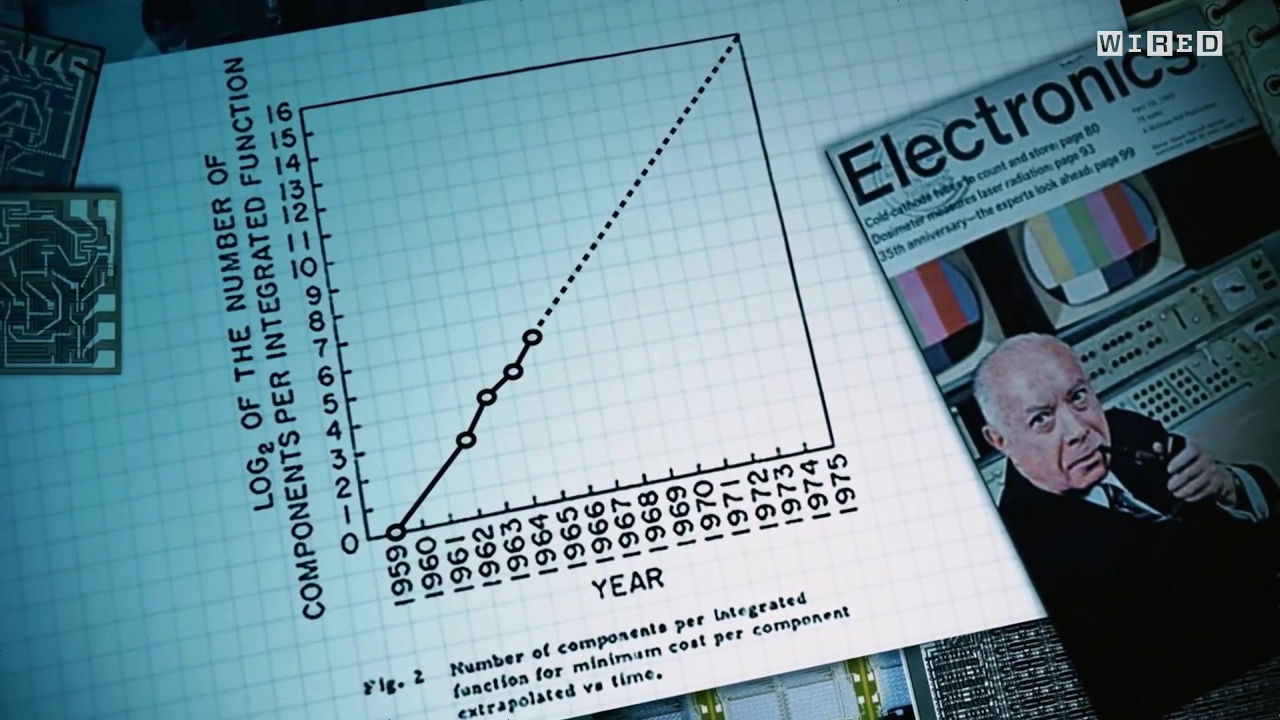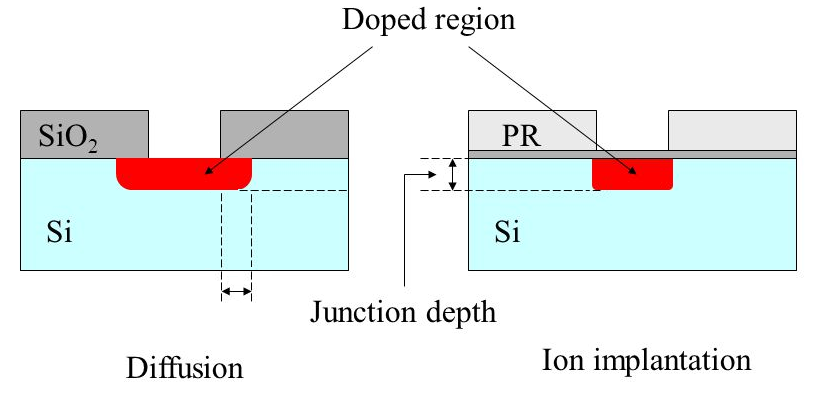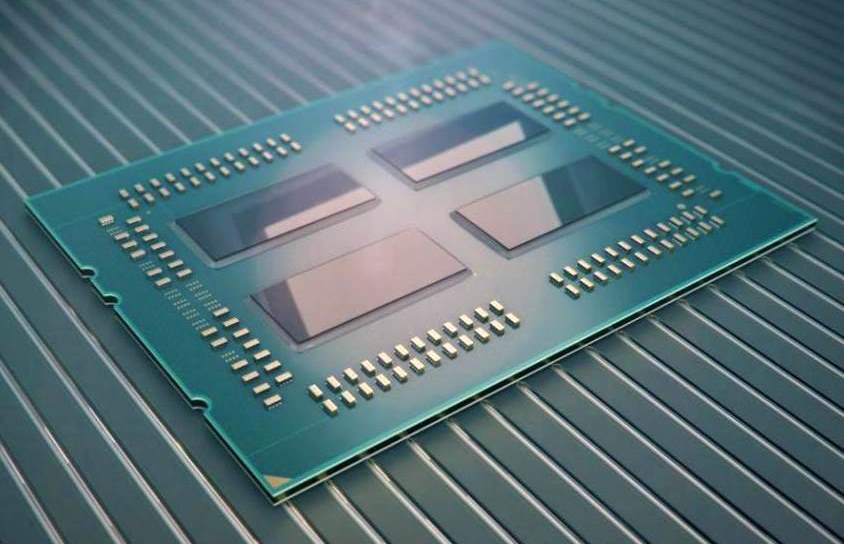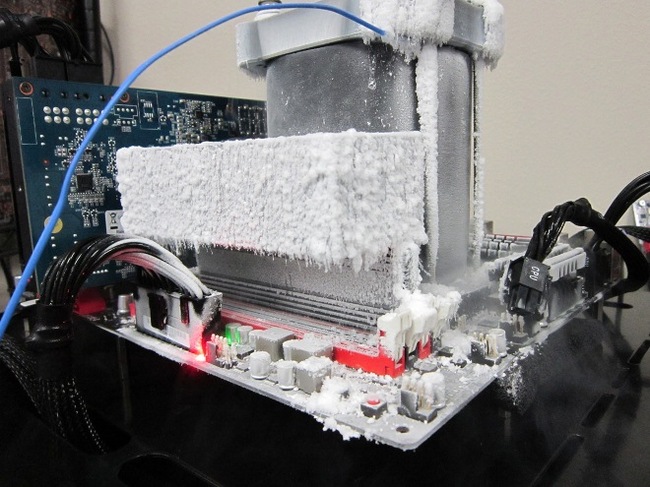Processors and marketing in computer technology
The problem of Moore's law. The decline of the microprocessor era when there are no alternatives.
Electronics magazine in 1965 published a well-known article on the integration of components of integrated systems, authored by Gordon Moore, who founded Intel in the future. At one time it was a sensation, especially at a time when the computer seemed incredible even to educated people. Moore analyzed the development of computer technology over the past 5 years and made a forecast for the next 10. Gordon Moore literally set the pace of technology development, and for four decades, processor developers have been following it. This law is not scientific, physical or any law as such, it is only the observation of one person over the development of one company, which suddenly began to work. It is worth understanding why?

Following this law, it is very simple to predict the development of it technologies and the companies that provide these technologies. It became clear that this is exactly what is needed for companies: the consumer expects a performance increase of twice every 2 years, and the manufacturer does not need to talk about it, the consumer expects it to do so. We can also say that this law regulates the pace of development. You can make a breakthrough, very modern technology, but after a long time it will be impossible to release something more technological. For the manufacturer it is very important to update the generations, the advantages of the new should be obvious, the price is usually lower, and the productivity is higher. Except for fairly cheap solutions. Here it is important to sell a large number of not-too-modern solutions, and only in this way will it bring in revenue, to update them almost meaningless. It was obvious even in those times, and the intel company adopted this law, began to follow it, and there the whole industry was tightened. It should be said that such laws are not too good. Their problem is in the very small flexibility of the very representation of increasing power with decreasing sizes. In pursuit of power, we constantly encounter a wall of limiting problems that we need to solve here and now, or the company will not be able to release a new generation of processors. Some of the limitations were very powerful, and this is a great merit of the people who made the architectures of these processors, that they managed to get around these limitations. This drove the entire industry, the late presentation of technologies in their not very high-quality form could indicate problems in the future. At other times, technology allowed us to create a real breakthrough, but it was decided to forget as a bad dream and still follow the law.
')
There are several major limitations to the development of processors:
-the technological problems of printing transistors of very small sizes.

Diffusion against ion implantation.
Two fundamentally different methods of printing semiconductors, on which depends how small the technical process we can print. If you do not go into complex terminology, then diffusion is described as follows: in thermal diffusion, the maximum impurity concentration is always on the surface and decreases monotonically with depth, i.e. With the help of some factors (temperature, concentration) we can regulate the rate of diffusion, but the process inevitably spreads in all directions (spreads) increasing the maximum possible technical process. But a more modern doping method came to replace it: during ion implantation, doping impurity atoms are ionized in a strong electric field and irradiated with an ion flow surface of the plate with an oxide mask prepared in advance, which allows us to control the process in all directions. At the moment, this method of doping still has potential and does not require replacement.

The propagation length of a wave of light obviously depends on its frequency. The 4000 MHz wave has a length of 7.5 cm. Considering that the wave in the processor does not propagate in a straight line, the maximum crystal size of the silicon processor is even smaller, the one that we are used to seeing, and it cannot be made larger.

With increasing frequency, the number of transistors and some other factors, heating is directly proportional to the increase. It should always be within reasonable limits, no one wants to buy a processor that will have to be cooled with the use of liquid nitrogen. Consumption decreases with decreasing process technology, since the light travels less distance and leads to less heat, the processor also heats unevenly, but for its effective cooling it is necessary to distribute the temperature.
In this case, the progressive increase in consumption from the processor frequency imposes a very rigid framework on the maximum frequency of the processor, some time ago it was not obvious, everyone represented the future processor with a frequency ten times higher than what we see now. Relatively speaking, increasing the frequency of the processor by 2 times gives us 2 to 2 times the power of the higher power consumption and heat dissipation. Nevertheless, even without increasing the clock frequency at the pace that was in the last century, Moore's law worked in a sense, and the processors did become more powerful in other ways.
<
The minimum dimension of the semiconductor gate of the transistor is limited not only by the technologies at which the smallest possible element size is achieved, but also by the size of the silicon crystal lattice. Its dimension is 0.5 nanometers, but definitely the element can not be the same size as the crystal lattice and close to it. It can be concluded that the minimum possible size of the shutter may be approximately 1 nanometer, but this loses its meaning, because so closely located shutters will not be able to work together with others, which will cause failures. It is difficult to predict what technologies will be used in the future, but, let's say, the size of the gate in 4 -5 nanometers can be considered the ultimate, but only for silicon.
Moore's Law and the modern market of processors.

The processor market has long been in stagnation. Not only is the development of new technologies gradually slowing down, so also these technologies do not bring an obvious increase in productivity. Nevertheless, we do not notice any problems, the new processors are still more powerful and better than the old ones. When core performance reaches its peak, multi-core and multithreading come to the rescue. A strategy for popularizing multi-core systems is a fairly promising development strategy. Its company adheres to AMD. Multi-core popularization is necessary because not all programs and applications support a large number of cores. Some even need one high-performance thread, which will be weaker in performance on a multi-core processor than on a processor with less than 8 threads (with a similar frequency and process technology). But you need to change it. A multi-core processor is much more multitasking when the program uses quite a few processor resources, but at the same time takes up a thread. A multi-core processor will obviously handle this better and be less loaded. We can only wait.
Electronics magazine in 1965 published a well-known article on the integration of components of integrated systems, authored by Gordon Moore, who founded Intel in the future. At one time it was a sensation, especially at a time when the computer seemed incredible even to educated people. Moore analyzed the development of computer technology over the past 5 years and made a forecast for the next 10. Gordon Moore literally set the pace of technology development, and for four decades, processor developers have been following it. This law is not scientific, physical or any law as such, it is only the observation of one person over the development of one company, which suddenly began to work. It is worth understanding why?

Following this law, it is very simple to predict the development of it technologies and the companies that provide these technologies. It became clear that this is exactly what is needed for companies: the consumer expects a performance increase of twice every 2 years, and the manufacturer does not need to talk about it, the consumer expects it to do so. We can also say that this law regulates the pace of development. You can make a breakthrough, very modern technology, but after a long time it will be impossible to release something more technological. For the manufacturer it is very important to update the generations, the advantages of the new should be obvious, the price is usually lower, and the productivity is higher. Except for fairly cheap solutions. Here it is important to sell a large number of not-too-modern solutions, and only in this way will it bring in revenue, to update them almost meaningless. It was obvious even in those times, and the intel company adopted this law, began to follow it, and there the whole industry was tightened. It should be said that such laws are not too good. Their problem is in the very small flexibility of the very representation of increasing power with decreasing sizes. In pursuit of power, we constantly encounter a wall of limiting problems that we need to solve here and now, or the company will not be able to release a new generation of processors. Some of the limitations were very powerful, and this is a great merit of the people who made the architectures of these processors, that they managed to get around these limitations. This drove the entire industry, the late presentation of technologies in their not very high-quality form could indicate problems in the future. At other times, technology allowed us to create a real breakthrough, but it was decided to forget as a bad dream and still follow the law.
')
There are several major limitations to the development of processors:
-the technological problems of printing transistors of very small sizes.

Diffusion against ion implantation.
Two fundamentally different methods of printing semiconductors, on which depends how small the technical process we can print. If you do not go into complex terminology, then diffusion is described as follows: in thermal diffusion, the maximum impurity concentration is always on the surface and decreases monotonically with depth, i.e. With the help of some factors (temperature, concentration) we can regulate the rate of diffusion, but the process inevitably spreads in all directions (spreads) increasing the maximum possible technical process. But a more modern doping method came to replace it: during ion implantation, doping impurity atoms are ionized in a strong electric field and irradiated with an ion flow surface of the plate with an oxide mask prepared in advance, which allows us to control the process in all directions. At the moment, this method of doping still has potential and does not require replacement.
- crystal dimension limits

The propagation length of a wave of light obviously depends on its frequency. The 4000 MHz wave has a length of 7.5 cm. Considering that the wave in the processor does not propagate in a straight line, the maximum crystal size of the silicon processor is even smaller, the one that we are used to seeing, and it cannot be made larger.
- the problem of high consumption of processors

With increasing frequency, the number of transistors and some other factors, heating is directly proportional to the increase. It should always be within reasonable limits, no one wants to buy a processor that will have to be cooled with the use of liquid nitrogen. Consumption decreases with decreasing process technology, since the light travels less distance and leads to less heat, the processor also heats unevenly, but for its effective cooling it is necessary to distribute the temperature.
In this case, the progressive increase in consumption from the processor frequency imposes a very rigid framework on the maximum frequency of the processor, some time ago it was not obvious, everyone represented the future processor with a frequency ten times higher than what we see now. Relatively speaking, increasing the frequency of the processor by 2 times gives us 2 to 2 times the power of the higher power consumption and heat dissipation. Nevertheless, even without increasing the clock frequency at the pace that was in the last century, Moore's law worked in a sense, and the processors did become more powerful in other ways.
- limitations of the dimension of the crystal lattice of silicon
<

The minimum dimension of the semiconductor gate of the transistor is limited not only by the technologies at which the smallest possible element size is achieved, but also by the size of the silicon crystal lattice. Its dimension is 0.5 nanometers, but definitely the element can not be the same size as the crystal lattice and close to it. It can be concluded that the minimum possible size of the shutter may be approximately 1 nanometer, but this loses its meaning, because so closely located shutters will not be able to work together with others, which will cause failures. It is difficult to predict what technologies will be used in the future, but, let's say, the size of the gate in 4 -5 nanometers can be considered the ultimate, but only for silicon.
Moore's Law and the modern market of processors.

The processor market has long been in stagnation. Not only is the development of new technologies gradually slowing down, so also these technologies do not bring an obvious increase in productivity. Nevertheless, we do not notice any problems, the new processors are still more powerful and better than the old ones. When core performance reaches its peak, multi-core and multithreading come to the rescue. A strategy for popularizing multi-core systems is a fairly promising development strategy. Its company adheres to AMD. Multi-core popularization is necessary because not all programs and applications support a large number of cores. Some even need one high-performance thread, which will be weaker in performance on a multi-core processor than on a processor with less than 8 threads (with a similar frequency and process technology). But you need to change it. A multi-core processor is much more multitasking when the program uses quite a few processor resources, but at the same time takes up a thread. A multi-core processor will obviously handle this better and be less loaded. We can only wait.
Source: https://habr.com/ru/post/444810/
All Articles